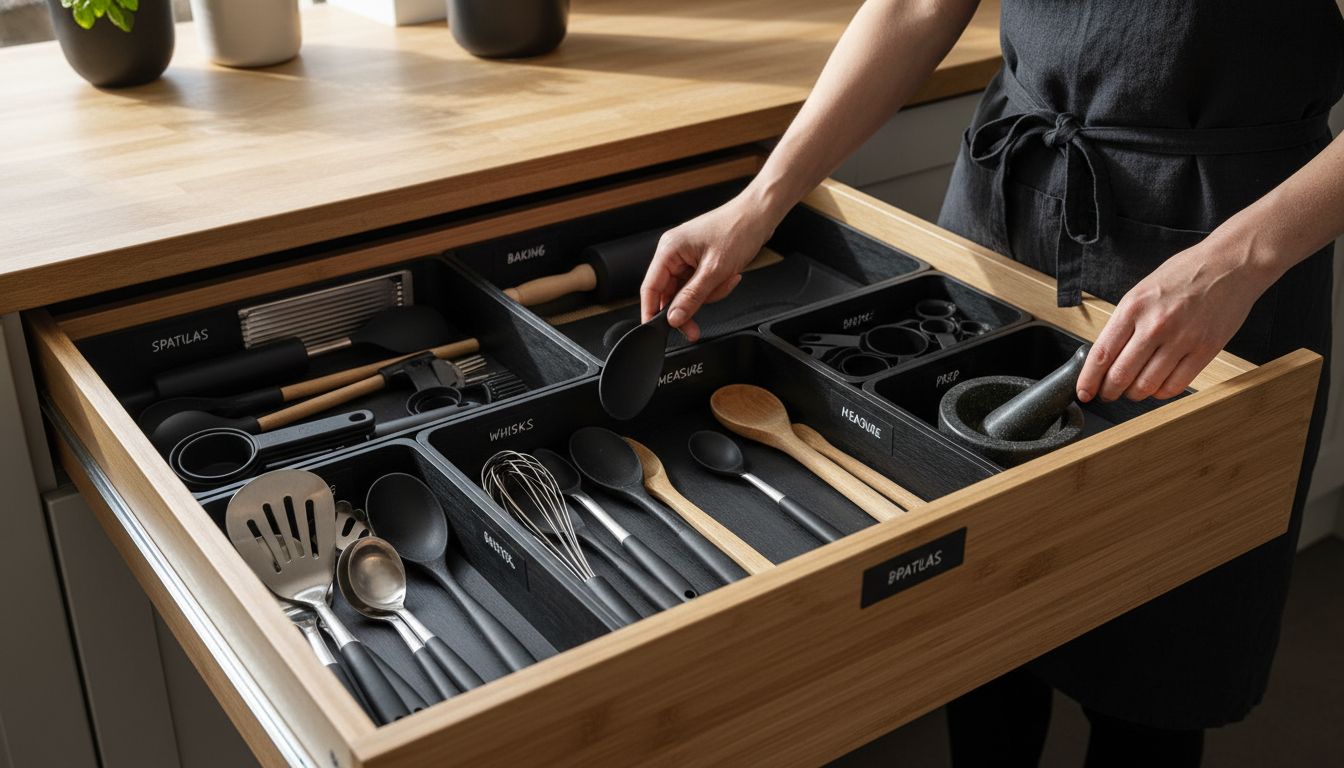Your Cart is Empty
Free Standard Shipping for Contiguous U.S. Orders!
Free Standard Shipping for Contiguous U.S. Orders!
Catalog

How to Organize Kitchen Drawers for Maximum Efficiency
October 29, 2025 9 min read
Did you know that the average person spends over 60 hours each year searching for misplaced kitchen items? Messy drawers can turn cooking into a daily challenge, leading to wasted time and constant frustration. A smarter organization system not only saves minutes during busy routines but also keeps your favorite tools at your fingertips. With simple steps and the right approach, you can transform cluttered drawers into efficient hubs designed for easy, enjoyable meal prep.
Table of Contents
- Step 1: Clear Out And Assess All Drawer Contents
- Step 2: Sort And Group Kitchen Items By Usage
- Step 3: Clean Drawers And Prepare For Organization
- Step 4: Select Eco-Friendly Organizers And Dividers
- Step 5: Arrange And Optimize Each Item’s Placement
- Step 6: Review And Adjust For Daily Kitchen Flow
Quick Summary
| Key Point | Explanation |
|---|---|
| 1. Clear and assess drawer contents | Remove all items to identify duplicates and unnecessary tools before reorganizing. |
| 2. Sort items by usage | Group kitchen tools into categories based on how often you use them for easier access and efficiency. |
| 3. Clean drawers thoroughly | Ensure drawers are hygienic by deep cleaning them before placing items back, preventing mold and damage. |
| 4. Use eco-friendly organizers | Choose sustainable materials for dividers that fit well, helping maintain an organized kitchen space. |
| 5. Regularly review and adjust organization | Periodically assess your setup and make changes based on your cooking habits to improve functionality. |
Step 1: Clear out and assess all drawer contents
Getting your kitchen drawers organized starts with a complete reset. By removing every single item, you create a blank canvas that allows you to thoughtfully reassess and reimagine your storage strategy.
Begin by pulling out all contents from each drawer. According to research from the Cozee Bay Organization Guide, this comprehensive approach helps you identify unnecessary duplicates and outdated tools that are just taking up valuable space. Spread everything out on a clean countertop or large table where you can see each item clearly.
As you empty each drawer, sort items into three distinct categories: keep, donate, and discard. Be ruthless in this process. If you have not used a kitchen tool in over a year or it is damaged beyond repair, it is time to let it go. For items that are still functional but no longer serve your current cooking needs, consider donating them to local shelters or community centers.
Pro Tip: Take a moment to wipe down the empty drawer with a gentle cleaner. This gives you a fresh start and removes any accumulated dust or grime before reorganizing.
Once you have sorted everything, you will be ready to design a more intentional and efficient drawer layout that actually works for your cooking and kitchen lifestyle. Your next step will involve selecting the right organizational tools to maximize your newly cleared drawer space.
Step 2: Sort and group kitchen items by usage
Now that your drawers are empty and decluttered, it is time to transform chaos into order by strategically grouping your kitchen items according to their function and frequency of use. This systematic approach will make your kitchen more intuitive and efficient.
Start by creating distinct categories based on how you actually cook and work in your kitchen. According to research from organizational experts, grouping similar items together dramatically improves accessibility and maintains order. In kitchen organization ideas for a clutter-free space, key functional groups might include baking tools, cooking utensils, cutting implements, and meal prep accessories.
Consider your daily cooking routines when establishing these categories. Place frequently used items like spatulas, whisks, and wooden spoons in easily accessible drawers near your primary cooking area. Less frequently used specialized tools can be stored in secondary or lower drawers. Lightweight plastic measuring cups could live together, while heavy cast iron implements might get their own dedicated space.
Pro Tip: Use drawer dividers or small containers to keep each category distinctly separated and prevent items from sliding around during drawer movement.
By thoughtfully organizing your kitchen items based on their usage patterns, you will create a more functional and streamlined cooking environment. The next step involves selecting the right organizational tools to maintain this newfound order.
Step 3: Clean drawers and prepare for organization
With your kitchen items sorted and removed, it is time to transform your drawers into pristine spaces ready for a strategic organizational makeover. Cleaning your drawers thoroughly is more than just a hygiene practice it sets the foundation for an efficient and well-maintained kitchen storage system.
Start by selecting the right cleaning supplies. According to research on kitchen organization, a thorough cleaning ensures a hygienic environment for your kitchen tools. In our guide to smart drawer organization ideas, we recommend using a mild all-purpose cleaner, soft microfiber cloths, and a gentle scrub brush for stubborn grime.
Begin by vacuuming out any loose crumbs or debris. Then apply your chosen cleaning solution, working from the back of the drawer to the front. Pay special attention to corners and edges where dirt tends to accumulate. Use a soft cloth to wipe down all surfaces, including the drawer sides and bottom. For wooden drawers, avoid saturating the surface and use a slightly damp cloth to prevent water damage.
Pro Tip: Allow drawers to air dry completely before replacing your organized items. This prevents moisture buildup and potential mold growth.
By investing time in a thorough cleaning, you are creating a fresh canvas for your new organizational system.
The next step involves selecting the right organizational tools to maintain your newly cleaned and prepared drawer spaces.
Step 4: Select eco-friendly organizers and dividers
With your drawers cleaned and ready, it is time to introduce smart organizational solutions that not only keep your kitchen tidy but also support environmental sustainability. Selecting the right eco-friendly organizers and dividers will transform your kitchen storage from chaotic to intentional.
Start by exploring sustainable materials that offer both functionality and environmental responsibility. In our comprehensive guide to organizing with bamboo products, we highlight bamboo as an exceptional material for drawer dividers. These natural wood organizers are not only durable and lightweight but also biodegradable and renewable.
Consider the specific needs of each drawer when selecting your organizers. Measure your drawer dimensions carefully to ensure a perfect fit. Look for adjustable bamboo dividers that can accommodate different utensil sizes and kitchen tool collections. Modular designs allow you to customize your storage approach, creating specific zones for cooking tools, baking accessories, and smaller kitchen gadgets.
Pro Tip: Choose organizers with multiple compartment sizes to accommodate both large cooking utensils and smaller items like measuring spoons or kitchen scissors.
By investing in thoughtful eco-friendly drawer organizers, you are creating an efficient kitchen space while supporting sustainable practices.
 Your next step involves strategically placing these new organizational tools to maximize your drawer functionality.
Your next step involves strategically placing these new organizational tools to maximize your drawer functionality.
Step 5: Arrange and optimize each item’s placement
With your eco-friendly organizers in place, it is time to strategically position your kitchen tools for maximum efficiency and accessibility. The goal is to create a drawer system that works intuitively with your cooking style and daily routines.
According to kitchen organization experts, placement is everything. In our guide to understanding bamboo organizers, we recommend prioritizing everyday utensils for the most convenient spots. Position your most frequently used tools like spatulas, wooden spoons, and everyday measuring cups in the front or center sections of your drawers where they can be easily grabbed during meal preparation.
Consider the ergonomics of your kitchen workflow when arranging items. Heavier tools like cast iron skillets or large mixing bowls should be placed in lower drawers to prevent strain when lifting. Lighter and smaller items such as measuring spoons, whisks, and peelers can be stored in upper drawer compartments. Group similar items together not just by type but also by how often you use them creating logical zones that streamline your cooking process.
Pro Tip: Leave a small amount of empty space in each drawer compartment to prevent overcrowding and make items easier to retrieve.
By thoughtfully arranging your kitchen tools, you transform your drawers from mere storage spaces into efficient workstations that enhance your cooking experience. Your final step involves maintaining this organizational system for long term success.
Step 6: Review and adjust for daily kitchen flow
Creating an organized kitchen is not a one-time event but an ongoing process of refinement. Your drawer organization system should be flexible and responsive to your changing cooking habits and lifestyle needs.
Periodically evaluate how well your current setup works by paying attention to your daily kitchen interactions. In our bamboo home organization guide, we recommend conducting a monthly review of your drawer arrangement. Observe which items you frequently reach for and which ones remain untouched. Are there tools that consistently feel inconvenient to access? Do you find yourself frustrated when searching for specific utensils?
Be prepared to make incremental adjustments. If you notice that baking tools are always slightly out of reach or that your most used spatulas require an awkward stretch, it is time to rearrange. Consider rotating less used items to back compartments and bringing frequently utilized tools to the most accessible zones. Small tweaks can dramatically improve your kitchen workflow and reduce daily frustration.
Pro Tip: Set a recurring calendar reminder every three months to reassess and optimize your drawer organization.
By treating your kitchen organization as a dynamic system that evolves with your needs, you create a space that truly supports your cooking style. Continuous small improvements will keep your kitchen functioning smoothly and efficiently.
Here’s a summary of each kitchen drawer organization step:
| Step | Main Action | Key Tips |
|---|---|---|
| Clear & Assess | Remove all items Sort into keep, donate, discard |
Be ruthless Wipe drawers clean |
| Sort & Group | Categorize by function and use | Place frequent items up front Use dividers |
| Clean Drawers | Deep clean all drawer surfaces | Use mild cleaner Let drawers dry |
| Choose Organizers | Select eco-friendly dividers | Measure for fit Pick modular options |
| Arrange Items | Strategically place tools | Store heavy tools low Leave space |
| Review & Adjust | Check and tweak system regularly | Monthly reviews Flex with habits |
Transform Your Kitchen Drawers with Eco-Friendly Bamboo Organizers
Struggling to keep your kitchen drawers tidy and efficient after decluttering and cleaning There is a perfect solution that blends sustainability with smart design. The article highlights the importance of using versatile, eco-friendly organizers to truly optimize drawer space and maintain order in your daily kitchen flow. Why settle for cluttered drawers when you can effortlessly create designated zones for utensils and tools with beautifully crafted bamboo dividers

Discover the elegance and functionality of our Drawer Organizers | Cozee Bay® designed to fit precisely and support effortless kitchen workflows. These bamboo organizers are durable, sustainable, and customizable letting you tailor your storage for frequent and special-use items alike. Pair your new setup with other innovative storage solutions like our Bag Organizer with Wrap Dispenser | Cozee Bay® bringing harmony to your entire food prep area. Ready to revolutionize your kitchen Join countless customers who trust Cozee Bay for stylish and practical bamboo home solutions. Shop now and start enjoying clutter-free, eco-conscious living today!
Frequently Asked Questions
How can I effectively clear and assess my kitchen drawer contents?
To clear and assess your kitchen drawer contents, remove all items and sort them into three categories: keep, donate, and discard. Be decisive in letting go of duplicates or unused items, then wipe down your empty drawers before reorganizing to create a fresh start.
What is the best way to group kitchen items for maximum efficiency?
Group kitchen items by their function and frequency of use to maximize efficiency. For example, store frequently used tools like spatulas in easily accessible spots, and consider separating items into categories such as baking tools and cooking utensils.
How should I clean my kitchen drawers before organizing?
Start by vacuuming out crumbs and debris from your kitchen drawers, then use a mild cleaner and a soft cloth to wipe all surfaces thoroughly. Allow the drawers to air dry completely to prevent any moisture issues before placing your organized items back inside.
What types of eco-friendly organizers should I consider for my kitchen drawers?
Choose organizers made from sustainable materials like bamboo, which are durable and biodegradable. Look for adjustable dividers that cater to the size and type of your kitchen tools, allowing you to create customized zones for each category of items.
How can I arrange kitchen items for easy access and workflow?
Place frequently used tools in the front or center of drawers for easy access, while storing heavy items in lower drawers to minimize strain. Leave some empty space in compartments to avoid overcrowding, making it easier to grab what you need while cooking.
How often should I review my kitchen drawer organization?
Conduct a monthly review of your kitchen drawer organization to assess how well your current setup meets your needs. Adjust the placement of items based on usage patterns, ensuring that your kitchen remains efficient and aligned with your cooking habits.
Recommended
Leave a comment
Comments will be approved before showing up.
Subscribe
Sign up to get the latest on sales, new releases and more …

